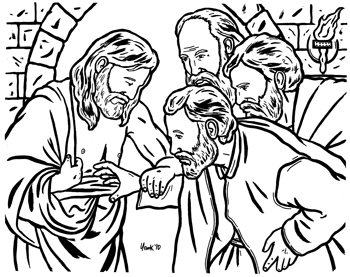Click on the photo for a printable PDF!
Based on the Gospel of John 20:19-31
Easter night. Behind locked doors of the upper room, the apostles huddle together, fearful that what happened to Jesus will happen to them, too.
Suddenly, Jesus appears in their midst and says, “Peace be with you.” To calm their fears and confusion, Jesus brings them peace, mercy and promises he’ll be with them always. He shows them the wounds in his hands and side. Joyfully, the apostles recognize Jesus.
Jesus says again, “Peace be with you. As the Father has sent me, so I send you.” He breathes on them and says, “Receive the Holy Spirit. Whose sins you forgive are forgiven them, and whose sins you retain are retained.” Jesus commissions the apostles to carry on his work – to forgive sins and to share his forgiveness, mercy, peace and love with all people. With the Holy Spirit’s help, they will spread the Good News.
The apostle Thomas wasn’t there when Jesus appeared. They tell him, “We have seen the Lord.” Thomas will not believe without seeing Jesus for himself.
A week later, although the doors are locked, Jesus again appears to the apostles, including Thomas. For a third time Jesus says, “Peace be with you.” He says to Thomas, “Put your finger here and see my hands, and bring your hand and put it into my side, and do not be unbelieving, but believe.” Thomas falls to his knees and says, “My Lord and My God!” Jesus tells Thomas, “Blessed are they who have not seen me but still believe in me.”
At Mass, we quietly pray, “My Lord and My God,” when the priest elevates Christ’s Body and Blood. We don’t see Jesus, but we believe he is really there! That’s faith – God’s special gift to us.
Easter isn’t only one day – it’s a season that lasts for 50 days from Easter Sunday through Pentecost. Pay close attention at Sunday Mass for the special songs, prayers, and readings telling us more about Jesus’ Resurrection and all that happened afterward when Jesus spent time with his apostles.
This first Sunday after Easter is known as Divine Mercy Sunday. In 2000, Pope John Paul II canonized a humble, young Polish nun – Sr. Faustina Kowalska – and named the first Sunday after Easter as Divine Mercy Sunday.
St. Faustina is known as the apostle of Divine Mercy because of Jesus’ appearances to her and his calls for people to come to him for forgiveness, healing and salvation. To learn about her life, the special picture of Jesus as the Image of The Divine Mercy, and the Divine Mercy Chaplet and Novena prayers, contact the National Shrine of The Divine Mercy in Stockbridge, Mass. (maintained by the religious order of priests known as the Marians of the Immaculate Conception) by visiting the Web site.
Jesus’ merciful love is without limits and given freely to us. He wants no one to miss out on his love and the help of his grace. “Jesus, I trust in you!”

